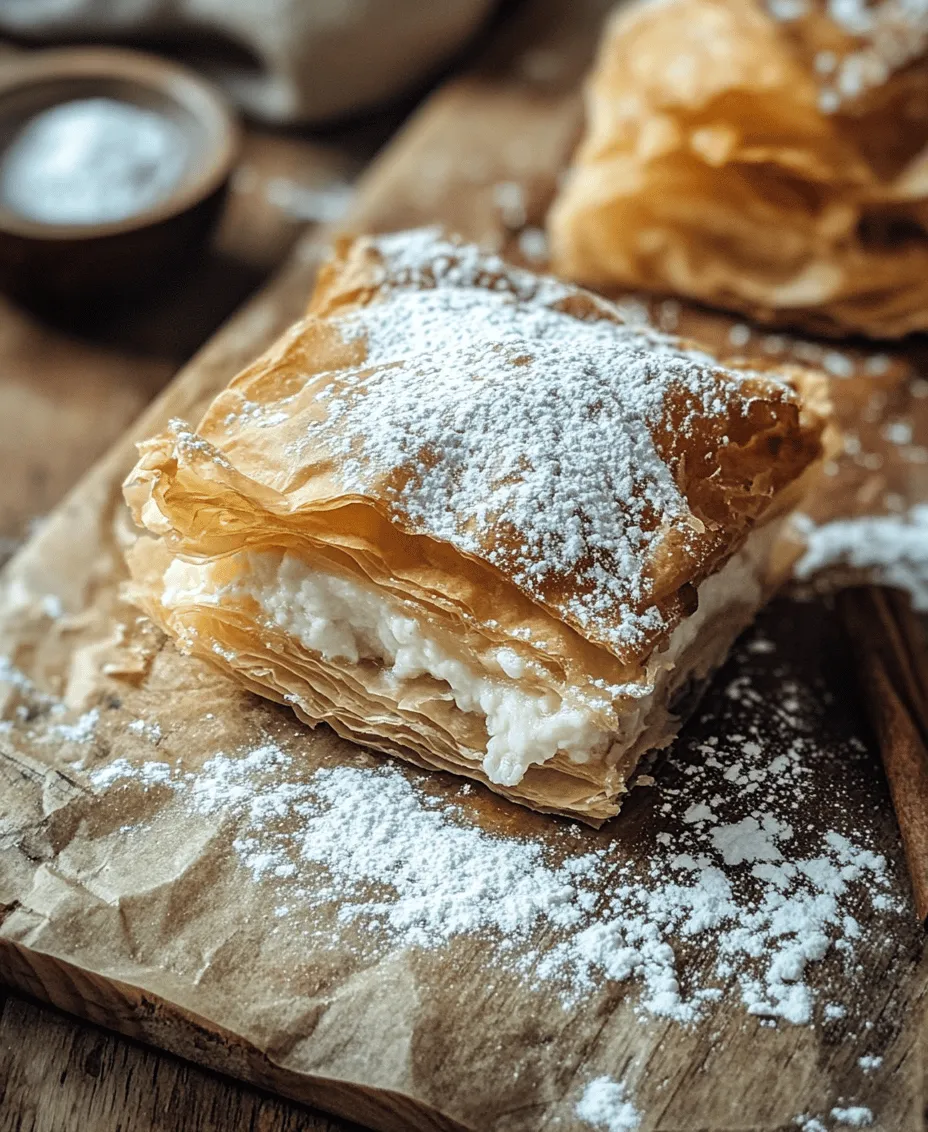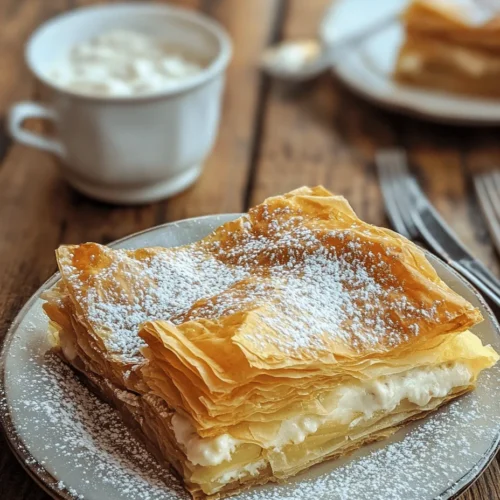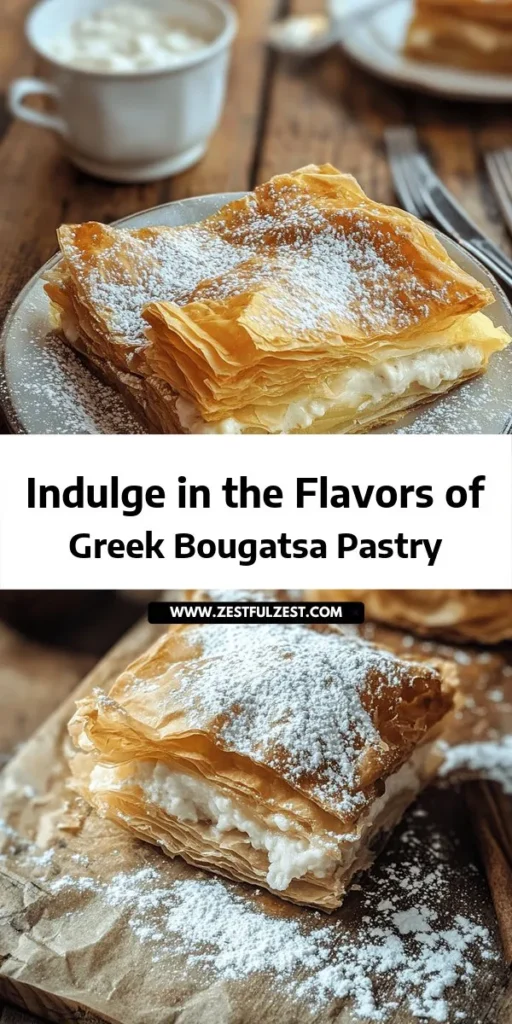Introduction to Bougatsa: A Delightful Greek Pastry
Bougatsa, a delectable pastry hailing from Greece, stands as a testament to the country’s rich culinary heritage. With its origins deeply rooted in the northern regions, particularly in Thessaloniki, bougatsa has evolved into a beloved treat that captures the hearts and palates of locals and visitors alike. Whether enjoyed as a breakfast item, snack, or dessert, this pastry has become synonymous with Greek comfort food. The cultural significance of bougatsa is profound; it is often associated with family gatherings, festivals, and local celebrations, making it not just a dish but a cherished tradition.
The allure of bougatsa lies in its unique combination of textures and flavors. At its core, it features a delicate, flaky phyllo pastry that encases a luscious filling, which can vary from sweet to savory. The most common filling is a creamy semolina custard, which offers a delightful contrast to the crispness of the phyllo. However, bougatsa is incredibly versatile; cheese and minced meat variations are equally popular, each providing a distinct palate experience. This diverse range makes bougatsa suitable for any time of day, appealing to both dessert lovers and those seeking a savory snack.
In this article, we will delve into the rich history and cultural significance of bougatsa, explore its regional variations, and guide you through the essential ingredients needed to recreate this delightful pastry in your own kitchen.
Understanding Bougatsa: Origins and Cultural Significance
The history of bougatsa is as layered as the pastry itself. It is believed that bougatsa originated in the Byzantine Empire, where it was known as a sweet or savory pie. Over centuries, this dish traveled through various cultures and regions, absorbing influences from each. The name “bougatsa” is thought to derive from the Turkish word “börek,” which refers to a pastry filled with cheese or meat, highlighting the interconnected culinary traditions of the Mediterranean.
In modern Greece, bougatsa is particularly associated with the city of Thessaloniki, where it is often enjoyed warm, fresh from the oven. The city boasts numerous bakeries dedicated to this pastry, each claiming to have the best recipe. Bougatsa is not just a treat; it’s a part of daily life in Greece. It is commonly found in breakfast menus, served alongside coffee, or enjoyed as a quick snack during the day. During special occasions and festivals, bougatsa takes center stage, celebrated for its comforting flavors and the joy it brings to gatherings.
Regional variations of bougatsa are plentiful. In Thessaloniki, sweet bougatsa filled with custard and topped with powdered sugar is a favorite. Meanwhile, in other regions, such as Crete, you might find savory versions filled with cheese or ground meat, each variation showcasing local ingredients and culinary styles. This rich diversity reflects the regional pride found in Greek cuisine, where each area has its unique spin on traditional dishes.
Ingredients Breakdown: What You Need for Bougatsa
Creating the perfect bougatsa requires a careful selection of ingredients, each contributing to the overall flavor and texture of the pastry. Below is a detailed breakdown of the essential ingredients you will need to make bougatsa, along with their roles in the recipe.
Phyllo Pastry
Phyllo pastry is the star of the show in bougatsa. It is crucial to use fresh, high-quality phyllo for optimal texture and flavor. The thin sheets of phyllo create the signature flaky layers that make bougatsa so irresistible. When baked, the phyllo becomes light and crispy, providing a delightful contrast to the creamy filling inside. If you are uncertain about handling phyllo, remember that it is essential to keep it covered with a damp cloth while working with it to prevent it from drying out.
Semolina Flour
Semolina flour plays a vital role in creating the creamy filling of bougatsa. This coarse flour, made from durum wheat, has a high gluten content, which helps achieve a smooth, custard-like consistency when combined with milk and eggs. Semolina is not only responsible for the texture of the filling but also adds a subtle nutty flavor that enhances the overall taste of the pastry. Moreover, it brings nutritional benefits, being a good source of protein and fiber.
Milk
Milk is another key ingredient in the filling, contributing to its richness and creaminess. Full-fat milk is recommended for the best results, as it adds a luxurious mouthfeel to the custard. The milk combines with the semolina and eggs during cooking, creating a smooth and indulgent filling that perfectly balances the crispness of the phyllo.
Eggs
Eggs serve multiple purposes in the bougatsa filling. They act as a binding agent, helping to hold the filling together while also adding richness and flavor. When cooked, eggs provide a silky texture to the custard, ensuring that each bite is satisfying. It is essential to whisk the eggs thoroughly before incorporating them into the filling to achieve a uniform consistency.
Sugar
For sweet variations of bougatsa, sugar is a crucial ingredient that balances the flavors in the filling. The sweetness of the sugar complements the creamy semolina, enhancing the overall taste profile of the pastry. In savory versions, you may omit sugar or reduce the amount, allowing the natural flavors of the cheese or meat to shine through.
Butter
Melted butter is essential for both the phyllo pastry and the filling. It adds flavor and helps achieve that golden-brown color when baked. Butter also contributes to the flaky texture of the phyllo, ensuring that each layer crisps up beautifully in the oven. Using high-quality butter will elevate the taste of your bougatsa, making it even more delectable.
With these ingredients in hand, you are well on your way to creating a traditional bougatsa that captures the essence of this beloved Greek pastry. In the next section, we will explore the detailed step-by-step instructions on how to prepare this delightful dish, ensuring that you can enjoy the authentic flavors of Greece right in your own home.

Vanilla Extract and Salt: Enhancing the Overall Flavor Profile
The secret to a truly delightful Bougatsa lies in the nuanced flavoring of its filling. The inclusion of vanilla extract is essential; it elevates the sweetness of the filling and adds a fragrant aroma that complements the creamy custard. A dash of salt is equally important, as it balances the flavors and enhances the sweetness, creating a harmonious taste experience. Always opt for pure vanilla extract for the best results, as artificial flavors can diminish the overall quality of your Bougatsa.
Powdered Sugar and Cinnamon: Garnishing Tips for Presentation
Once your Bougatsa is baked to golden perfection, the final touch is crucial for both flavor and presentation. A generous dusting of powdered sugar and a sprinkle of ground cinnamon not only adds an appealing sweetness but also enhances the visual appeal with a contrasting color against the crisp pastry. For an extra pop, consider adding a few crushed nuts on top, such as almonds or walnuts, which can provide both texture and a nutty flavor that complements the filling beautifully.
Step-by-Step Guide to Making Bougatsa
Preparing the Filling
To create the ideal filling for your Bougatsa, start by combining the milk, sugar, and semolina in a saucepan. Heat this mixture over medium heat, stirring continuously to avoid any lumps. As the mixture thickens, it will take on a creamy consistency. This process usually takes about 10-15 minutes. Once you achieve the desired thickness, remove it from the heat and let it cool slightly before adding the egg mixture. This ensures that the eggs do not cook prematurely when mixed in.
Combining with Eggs
In a separate bowl, whisk together the eggs until they are light and frothy. To temper the eggs—preventing them from scrambling—slowly add a small amount of the warm milk mixture into the eggs while continuously whisking. This gradual introduction of heat allows the eggs to adjust without curdling. Once the egg mixture is warm, combine it thoroughly with the remaining milk mixture. You’ll know it’s ready when it has a smooth and creamy texture without any lumps.
Preparing the Phyllo
Handling phyllo pastry can be delicate, but with a few tips, you can master it. Start by ensuring that your phyllo sheets are thawed completely; if they are frozen, leave them in the refrigerator overnight. When you’re ready to work with the sheets, keep them covered with a damp cloth to prevent them from drying out. This step is crucial, as dried phyllo can tear easily. Be gentle when unrolling the sheets, and use a sharp knife or pizza cutter to trim them if necessary, ensuring they fit your baking dish.
Adding the Filling
When you’re ready to assemble your Bougatsa, lay out one sheet of phyllo and brush it lightly with melted butter. Layer another sheet on top and repeat this process until you have about four layers. Then, spoon a portion of the filling along one edge of the pastry, leaving some space at the ends for sealing. You can choose to roll the pastry into logs for individual servings or fold it into coils for a more traditional presentation. If opting for logs, roll tightly but gently, ensuring the filling stays inside. If you prefer coils, twist the ends to create a spiral shape.
Baking the Bougatsa
Preheat your oven to 375°F (190°C), ensuring it’s hot enough to create that perfectly flaky texture. Arrange your Bougatsa on a baking sheet lined with parchment paper, and brush the tops with a final layer of melted butter to encourage browning. Bake for approximately 30-35 minutes or until the pastry is golden brown and crisp. You’ll know it’s done when the filling bubbles slightly and the pastry is beautifully browned. Allow the Bougatsa to cool for a few minutes before dusting with powdered sugar and cinnamon.
Serving Bougatsa: Presentation and Pairing Ideas
Bougatsa is best enjoyed warm, and the ideal way to serve it is with a generous dusting of powdered sugar and cinnamon on top. This not only enhances the flavor but also creates an inviting look that will impress your guests. For a traditional Greek experience, pair your Bougatsa with a steaming cup of Greek coffee, which has a robust flavor that complements the sweetness of the pastry. Alternatively, a refreshing cup of herbal tea can also provide a lovely contrast.
This delightful pastry is versatile enough to be enjoyed at any time of the day. Serve Bougatsa as a breakfast item, a sweet dessert after dinner, or a mid-afternoon snack. Its rich filling and flaky exterior make it a satisfying choice for any occasion.
Conclusion: Enjoying Bougatsa at Home
Bougatsa is not just a pastry; it’s a culinary tradition that brings a taste of Greece into your home kitchen. Its delightful combination of flaky phyllo and creamy filling makes it a versatile treat that can be enjoyed any time of the day. The joy of creating Bougatsa lies in the process, from mastering the handling of phyllo pastry to experimenting with various fillings.
Encourage yourself to try different flavor combinations, such as adding citrus zest or experimenting with nuts in the filling. Sharing Bougatsa with family and friends creates moments of warmth and connection, making each bite a celebration of Greek culture and hospitality. Whether you’re making it for a special occasion or simply to satisfy your cravings, Bougatsa is sure to become a beloved favorite in your home. So gather your ingredients, roll out your phyllo, and experience the joy of making this delightful Greek pastry today!



